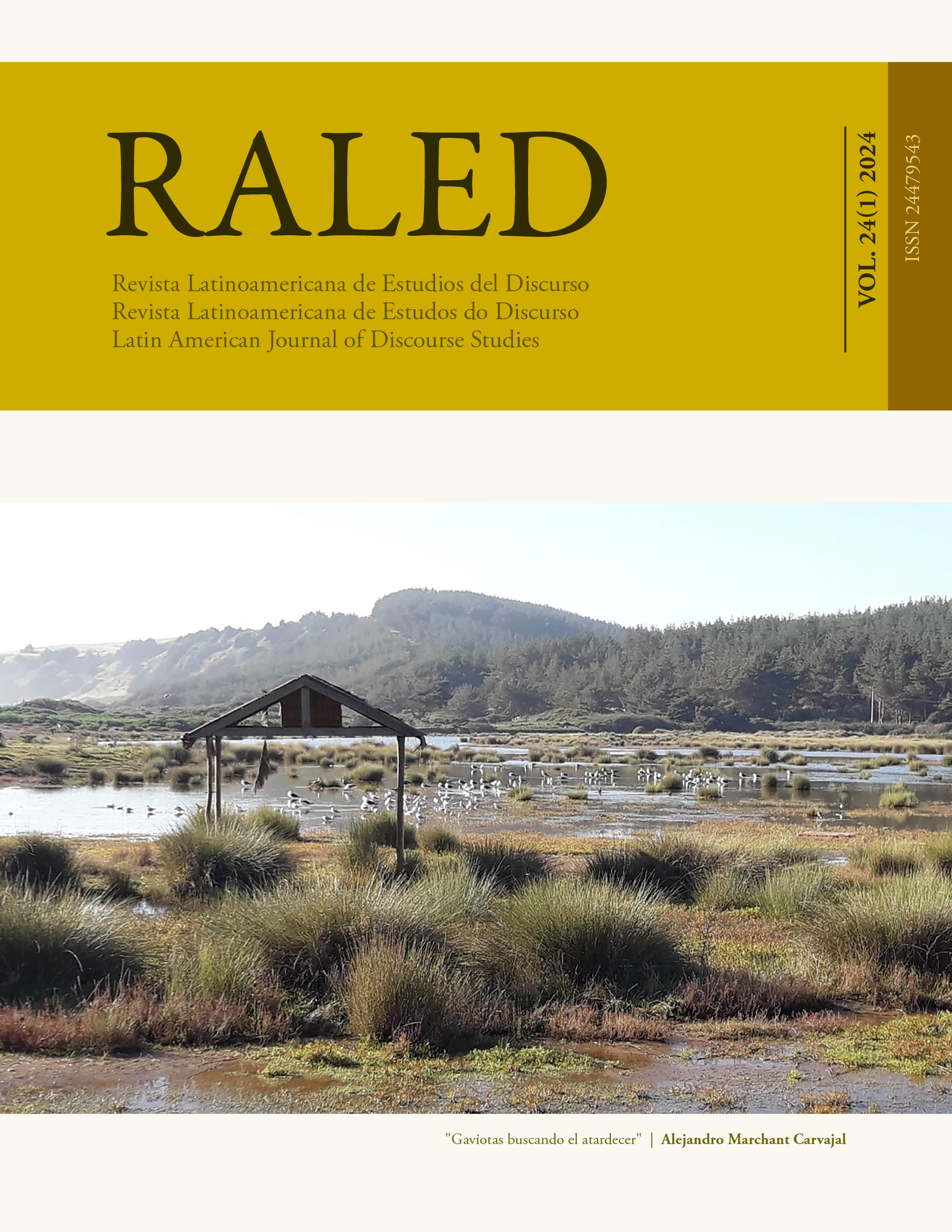"Cada like es un migrante menos en nuestro país”: Estudio del discurso xenofóbico en México en un corpus de YouTube
DOI:
https://doi.org/10.35956/v.24.n1.2024.p.86-105Palavras-chave:
Migração. América Central. México. Xenofobia. Ativação lexical. YouTube.Resumo
Este estudo descritivo dos discursos migratórios da América Central utiliza a Teoria da Ativação Lexical (Hoey 2005) para encontrar os usos ideológicos por trás do padrão linguístico <possessivo + lugar (casa, país, nação)>. Esta exploração é realizada com materiais de um corpus composto por comentários a vídeos publicados na plataforma YouTube sobre as caravanas de migrantes que atravessam o México a caminho dos Estados Unidos. Os resultados indicam usos concretos e metafóricos que, em sua maior parte, apoiam os discursos nacionalistas mexicanos contra os migrantes centro-americanos. O agrupamento semântico dos verbos que acompanham este padrão indica os medos (fobias, preconceitos) que os utilizadores da plataforma expressam em relação aos migrantes.
Downloads
Referências
Anthony, L. 2022. AntConc (v.4.0.3) [Computer Software]. Waseda University, Tokyo
Real Academia Española. 2023. Lugar | Diccionario de la lengua española. - Edición del Tricentenario. Recuperado 22 de mayo de 2023, de https://dle.rae.es/lugar
Real Academia Española. 2023. Migrar | Diccionario de la lengua española. - Edición del Tricentenario. Recuperado 17 de abril de 2023, de https://dle.rae.es/migrar
Baker, H., McEnery, T., y Hardie, A. 2017. A corpus-based investigation into English representations of Turks and Ottomans in the early modern period. En M. Pace-Sigge y K. J. Patterson (eds). Lexical Priming: Applications and Advances, pp. 41-66. Ámsterdam/ Filadelfia: John Benjamins Publishing Company
Baker, P., y McEnery, T. 2005. A corpus-based approach to discourses of refugees and asylum seekers in UN and newspaper texts. Journal of Language and Politics, 4, 2: 197-226.
Bevitor, C. 2018. Crossing Boundaries: Investigating «Fair» in British Parliamentary Debates on Im/migration. Textus 1: 165-186.
Church, K, y Hanks, P. 1990. Word Association Norms, Mutual Information, and Lexicography. Computational Linguistics 161: 22-29.
Dobrić Basaneže, K. y Ostojić, P. 2021. Migration Discourse in Croatian News Media. Medijska Istraživanja 27, 1: 5-27.
Douglas. S. M, 2008. La racialización de los mexicanos en Estados Unidos: estratificación racial en la teoría y en la práctica. Migración y Desarrollo 10: 65-95.
Fairclough, N. 2013. Critical Discourse Analysis: The Critical Study of Language. 2.a ed. London: Routledge.
Fotopoulos, S. y Kaimaklioti, M. 2016. Media Discourse on the Refugee Crisis: On what have the Greek, German and British Press Focused? European View 15, 2: 265-279.
Fowler, R. 1991. Language in the News: Discourse and Ideology in the Press. Nueva York: Routledge.
Gabrielatos, C. y Baker, P. 2008. Fleeing, Sneaking, Flooding: A Corpus Analysis of Discursive Constructions of Refugees and Asylum Seekers in the UK Press, 1996-2005. Journal of English Linguistics 36, 1: 5-38.
Hardt-Mautner, G. 1995. ‘Only Connect.’ Critical Discourse Analysis and Corpus Linguistics. Harris, L. H. y Fiske, S. 2006. Dehumanizing the Lowest of the Low: Neuroimaging Responses
to Extreme Out-Groups. Psychological Science 17, 10: 847-53.
Hoey, M. 2005. Lexical priming: A new theory of words and language. Abingdon: Routledge
Hoey, M. 2017. Cohesion and coherence in a content-specific corpus. En M. Pace-Sigge, M. y Patterson, K. J. (eds). Lexical Priming: Applications and Advances, pp. 41-66. Ámsterdam/ Filadelfia: John Benjamins Publishing Company
Montali, L., Riva, P., Frigerio, A. y Mele, S. 2013. The representation of migrants in the Italian press: A study on the Corriere della Sera (1992–2009). Journal of Language and Politics 12, 2: 226-250
Porto Dapena, J. Á. 1982. Los posesivos personales del español: Intento de descripción funcional. Dicenda. Estudios de lengua y literatura españolas 1: 55-108.
Reyes Vázquez, J. F. y Barrios de la O, M. I. 2019. El comportamiento de los usuarios de Twitter respecto al tema de la Caravana Migrante a través del Sentiment Analysis, De política 13, 7: 11
Simpson, P. 1993. Language, Ideology and Point of View. London: Routledge
Stubbs, M. 1995. Collocations and cultural connotations of common words. Linguistics and Education 7, 4: 379-390
Stubbs, M. 1996. Text and Corpus Analysis. Oxford: Blackwell.
Stubbs, M. 1997. Whorf ’s children: Critical comments on critical discourse analysis (CDA). British studies in applied linguistics 12: 100-116.
Stubbs, M. 2001. Computer-assisted Text and Corpus Analysis: Lexical Cohesion and Communicative Competence. En Schiffrin, D., Tannen, D., y Hamilton, H. E. The Handbook of Discourse Analysis. John Wiley & Sons.
Taylor, C. 2009. The representation of the inmigrants in the italian Press. Università Degli Studi Di Siena Dipartimento Di Scienze Storiche, Giuridiche, Politiche E Sociali.
Taylor, C. 2014. Investigating the representation of migrants in the UK and Italian press: A cross-linguistic corpus-assisted discourse analysis. International Journal of Corpus Linguistics 19, 3, 368-400.
Taylor, C. y Marchi, A. 2018. Corpus Approaches to Discourse: A Critical Review. Abingdon New York: Routledge.
Van Dijk, T. (ed.). 2016. Racismo y discurso en América Latina. Barcelona: Gedisa.
Wang, L., Ma, Q., Song, Z., Shi, Y., Wang, Y. y Pfotenhauer, L. 2011. N400 and the activation of prejudice against rural migrant workers in China. Brain research 1375:103-10.
White, K., Crites J. R. S., Taylor, J. y Corral, G. 2009. Wait, what? Assessing stereotype incongruities using the N400 ERP component. Social Cognitive and Affective Neuroscience 4(2):191-98.
Downloads
Publicado
Como Citar
Edição
Seção
Licença
Copyright (c) 2024 Ana Ruth Sánchez Barrera, Ignacio Rodríguez Sánchez

Este trabalho está licenciado sob uma licença Creative Commons Attribution-NonCommercial-NoDerivatives 4.0 International License.
Os/As autores/as conservam os direitos autorais e garantem a RALED o direito de ser a primeira publicação do trabalho licenciado por uma Creative Commons Attribution License que permite compartilhar o trabalho com reconhecimento de sua autoria e a publicação inicial nesta revista.




